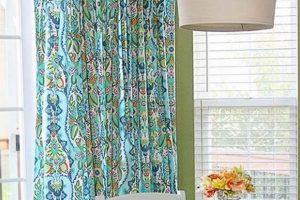A decorative window treatment, often constructed at home, serves to conceal curtain hardware or provide an aesthetic flourish to a room. These window coverings are typically mounted above the window and come in various styles, from simple fabric panels to more elaborate upholstered designs. For example, a homeowner might create a simple, no-sew option using foam board and fabric remnants, or construct a more complex tailored option complete with lining and embellishments.
These window accents offer a cost-effective way to enhance the visual appeal of a space, allowing for personalization that complements existing decor. Historically, they evolved from purely functional draperies to elements of decorative design, reflecting changing tastes and available materials. The ability to customize the size, fabric, and style ensures a cohesive design scheme, and the construction process can be a rewarding creative outlet.
The following sections will explore different approaches to constructing personalized window decor, providing guidance on material selection, construction techniques, and various design options to suit diverse aesthetic preferences and skill levels.
Construction Advice for Window Treatments
The following advice aims to improve the quality and longevity of self-made window decor, ensuring a professional finish and a satisfying outcome.
Tip 1: Accurate Measurements are Paramount. Precise measurements of the window frame are essential to ensure proper fit. Incorrect dimensions can lead to an ill-fitting final product, requiring significant alterations or a complete rebuild.
Tip 2: Fabric Selection Should Prioritize Durability and Cleanability. Consider the environment where the window treatment will be installed. High-traffic areas or kitchens may necessitate more durable, stain-resistant fabrics that are easily cleaned.
Tip 3: Lining Improves Longevity and Appearance. Adding a lining to the constructed piece provides structure, prevents fading, and improves the overall drape and appearance of the finished product. A blackout lining can be used to block light effectively.
Tip 4: Secure Mounting is Crucial. The chosen mounting hardware should be appropriate for the weight of the finished item. Insufficiently secured hardware can lead to the unit falling, potentially causing damage or injury.
Tip 5: Consider Scale and Proportion. The size and style should be proportionate to the size of the window and the overall dimensions of the room. An oversized or overly elaborate design can overwhelm a small space.
Tip 6: Seam Finishing Prevents Fraying. Proper seam finishing techniques, such as serging or using a zig-zag stitch, will prevent fabric edges from fraying over time, extending the life of the window treatment.
Tip 7: Pressing is Essential for a Professional Finish. Pressing seams and edges during construction will result in a cleaner, more professional-looking final product. Proper pressing is as important as accurate stitching.
Adhering to these guidelines will improve the quality and longevity of the window decoration, ensuring a pleasing aesthetic and a worthwhile investment of time and resources.
The next section will address specific design styles and construction methods, building upon the foundational advice presented here.
1. Fabric Selection
Fabric selection directly dictates the aesthetic and functional characteristics of a homemade window treatment. The material’s weight, texture, pattern, and color contribute significantly to the overall visual impact and durability of the completed piece. For example, a lightweight cotton fabric might be suitable for a casual, airy bedroom, while a heavier brocade could lend a more formal and opulent feel to a living room. Therefore, the choice of fabric is not merely a stylistic preference but a critical component that influences both the look and longevity of the design.
Furthermore, fabric selection affects the ease of construction. Some materials, such as felt or canvas, are more forgiving and easier to work with for novice sewers due to their stability and resistance to fraying. Conversely, more delicate fabrics like silk or chiffon require advanced sewing skills and meticulous handling to prevent damage. The intended construction method, whether sewn, glued, or stapled, must align with the properties of the chosen fabric to ensure a successful outcome. The durability of the fabric also impacts the long-term maintainability of the window covering; materials prone to fading or staining may require more frequent cleaning or replacement, increasing the overall cost and effort involved.
In conclusion, fabric choice represents a fundamental decision in the process of constructing window decor, with far-reaching implications for aesthetics, durability, ease of construction, and long-term maintenance. Neglecting careful consideration of these factors can lead to a final product that fails to meet expectations in terms of both visual appeal and functional performance. The effective implementation hinges on understanding the specific characteristics of various fabrics and their suitability for the intended purpose and design.
2. Style Considerations
Style considerations form a critical aspect of any personalized window decor project. The chosen design aesthetic directly influences material selection, construction techniques, and the final visual impact of the treatment within the space. The decision-making process for ‘diy valance ideas’ necessitates a clear understanding of design principles and their practical application.
- Complexity of Design
The complexity of the design dictates the skill level and time commitment required for construction. A simple, straight design demands basic sewing skills, while a more elaborate, shaped structure may necessitate advanced techniques, such as pattern drafting and precise seam construction. A design incorporating pleats or swags adds visual interest but also increases the difficulty of the project. The choice of complexity directly impacts the feasibility and satisfaction derived from the creation.
- Formal vs. Informal Aesthetic
The desired level of formality influences both the fabric and design choices. Formal designs often incorporate luxurious fabrics, such as silk or velvet, and feature tailored shapes and intricate details, like tassels or embellishments. Informal designs tend to utilize more casual fabrics, such as cotton or linen, and embrace simpler shapes with a relaxed, unfussy appearance. The selection of appropriate materials and design elements contributes to achieving the desired atmosphere within the room.
- Matching Existing Decor
The style of the personalized window treatment should complement the existing dcor. The design should be cohesive with the colors, patter
ns, and textures present in the room. A modern space may benefit from a minimalist design in neutral tones, while a traditional room might call for a more ornate treatment with rich colors and classic patterns. The window treatment should integrate seamlessly with the overall design scheme, enhancing rather than clashing with the existing aesthetic. - Functionality Considerations
Beyond aesthetics, the style should consider the functionality of the treatment. If light control is a primary concern, a design that allows for easy adjustment of light levels is desirable. For example, a design with adjustable panels or layers can provide flexibility in managing natural light. If privacy is paramount, a design that fully obscures the window when closed is necessary. Balancing style with functional requirements is essential for a successful integration.
These elements of style directly influence material selection, construction methods, and the overall success of the project. A thorough consideration of the factors discussed enables the creation of personalized window decor that enhances the aesthetic and functional qualities of the space. Ignoring these considerations can lead to a visually unappealing or functionally inadequate finished product, diminishing the value and satisfaction derived from the endeavor.
3. Measurement Accuracy
The precision of measurements directly dictates the success of personalized window treatments. Inaccurate dimensions inevitably lead to fitting issues, aesthetic compromises, and potential material waste. Therefore, accurate measurements are not merely a preliminary step but a foundational requirement.
- Window Frame Dimensions
The initial measurement of the window frame establishes the fundamental parameters for the design. Inaccurate width or height measurements result in a unit that is either too small, leaving unsightly gaps, or too large, preventing proper installation. For example, a miscalculation of even a quarter of an inch can lead to noticeable asymmetry or functional impairment of the window covering.
- Fabric Calculations
Fabric calculations are intrinsically linked to accurate measurements. Incorrect dimensions lead to underestimation or overestimation of required fabric. Underestimation necessitates purchasing additional fabric, potentially resulting in mismatched dye lots or unavailable materials. Overestimation generates unnecessary expense and material waste. Precise measurements ensure efficient resource utilization and cost-effectiveness.
- Hardware Placement
Hardware placement relies on the initial measurements of the window frame and the finished dimensions. Incorrect placement results in an unstable or aesthetically unappealing installation. For example, misaligned brackets lead to uneven hanging and potential structural failure over time. Accurate measurements guarantee secure and balanced hardware placement, ensuring the longevity and stability of the treatment.
- Pattern Matching
For patterned fabrics, accurate measurements are crucial for pattern matching. Incorrect dimensions disrupt the visual continuity of the pattern, resulting in a disjointed and unprofessional appearance. Precise measurements enable accurate pattern alignment, ensuring a seamless and visually appealing final product. This is particularly important for complex or large-scale patterns, where even small discrepancies are readily apparent.
In summary, the accuracy of measurements serves as a cornerstone of the entire process. A lack of precision at any stage undermines the aesthetic appeal, functional performance, and economic viability of self-made window treatments. Therefore, careful attention to detail and meticulous measurement practices are essential to ensure a satisfactory and long-lasting outcome.
4. Construction Method
The chosen construction method directly influences the aesthetic possibilities, structural integrity, and overall cost-effectiveness of personalized window treatments. The selection of a suitable construction technique is paramount, as it dictates the feasibility of specific designs and impacts the durability and maintainability of the finished product. The execution of the method determines the quality and longevity of the final piece.
- Sewn Construction
Sewn construction, involving the use of a sewing machine and various stitching techniques, provides the most versatility and structural integrity. This method allows for intricate designs, durable seams, and the incorporation of lining and embellishments. A tailored design with precise pleats and reinforced edges exemplifies sewn construction. However, sewn construction requires a certain level of skill and access to sewing equipment, which can be a barrier to entry for some. If executed properly, it extends the life of the fabric window decor considerably. It ensures the material’s reliable performance throughout its lifespan. The implications of using this construction method are a more durable, long-lasting, and professionally appearing final project.
- No-Sew Construction
No-sew construction bypasses the need for sewing equipment, relying instead on adhesives, staples, or fusible interfacing. This method is ideal for simple designs, quick projects, and individuals lacking sewing skills. A basic, flat panel design using fabric glue and a tension rod exemplifies no-sew construction. While easier and faster than sewn construction, no-sew methods generally result in less durable treatments and are limited in design complexity. Its accessibility makes it a viable option for basic designs. The implications of this option are simpler but less durable design is final outcome.
- Upholstered Construction
Upholstered construction involves wrapping fabric around a solid frame, such as wood or foam board, and securing it with staples or tacks. This method is suitable for creating structured, three-dimensional designs with clean lines and a tailored appearance. A shaped window decor mounted on a wooden frame exemplifies upholstered construction. Upholstered construction demands precision and attention to detail to ensure a smooth, wrinkle-free finish. It is more rigid and offers unique design possibilities. It has a unique result that gives the window decor a solid and structural look. The implications here are creating structural designs, using material durability, and requires detailed work.
- Combination Techniques
A combination of construction techniques can be employed to achieve specific design goals or to leverage the strengths of different methods. For example, a tailored design might incorporate sewn seams for durability and glued elements for decorative embellishments. Such an approach allows for greater flexibility and creativity in the design process. This technique results in a complex design and requires creative construction processes. The technique enables an easy design and enhances durability to the project. The implications include more flexible designs, combining design elements, and enhancing creativity.
The selection of the optimal construction method relies on a careful evaluation of skill level, available resources, desired aesthetic, and functional requirements. Each method presents unique advantages
and limitations, impacting the feasibility, cost, and durability of personalized window decor. A comprehensive understanding of these factors enables a more informed decision, resulting in a final product that meets both aesthetic and functional expectations. This allows for a well-balanced project.
5. Mounting Hardware
The selection and installation of mounting hardware are integral to the successful execution of any personalized window decor project. The hardware not only secures the unit but also influences its aesthetic presentation and functional performance. Improper hardware selection or installation jeopardizes the structural integrity and visual appeal of the finished project.
- Bracket Selection
Bracket selection should align with the weight and style of the finished piece. Lightweight designs may require simple, inconspicuous brackets, while heavier, more elaborate designs necessitate sturdier brackets capable of supporting the additional weight. An example is utilizing decorative wrought-iron brackets for a heavier, upholstered unit versus using simple L-brackets for a lighter, fabric-only design. Inadequate bracket strength leads to sagging or detachment, while inappropriate styling detracts from the overall aesthetic.
- Rod Selection
For designs incorporating a rod for draping fabric, the rod selection must correspond to the width of the window and the weight of the fabric. A thin, flimsy rod may bend or break under the weight of heavier fabrics, while a rod that is too short will not adequately span the window. For instance, a tension rod may be suitable for lightweight, no-sew panels, whereas a sturdy metal rod with finials is preferable for heavier, lined designs. Inadequate rod strength results in sagging or collapse, while improper rod length compromises the design’s proportions.
- Installation Technique
Proper installation technique is crucial for ensuring the stability and longevity of the window decor. The chosen hardware must be securely anchored to the wall, utilizing appropriate screws and anchors for the wall type (e.g., drywall, plaster, wood). For example, using drywall anchors for a heavy design ensures a secure hold and prevents the unit from pulling away from the wall. Improper installation leads to unstable mounting and potential damage to the wall or the finished piece.
- Concealment and Aesthetics
The mounting hardware should ideally be concealed or complement the aesthetic of the window decor. Unattractive or obtrusive hardware detracts from the overall visual appeal of the project. For example, using paintable brackets that match the wall color or decorative finials that coordinate with the fabric pattern can enhance the aesthetic integration of the mounting hardware. Poorly concealed or aesthetically mismatched hardware diminishes the visual impact of the design.
Effective hardware selection and installation are crucial for ensuring the stability, functionality, and aesthetic integration of personalized window treatments. Neglecting these considerations compromises the overall success of the project and diminishes the value of the time and resources invested.
6. Room Aesthetics
The overarching design scheme of a room necessitates careful consideration when implementing personalized window treatments. These treatments are not isolated elements but integral components that must harmonize with the existing aesthetic to create a cohesive and visually pleasing environment. Integrating window decor with room aesthetics elevates the space.
- Color Palette Harmony
The color palette establishes the mood and visual coherence of a room. Window treatments should complement or subtly contrast with the existing color scheme. For example, in a room with cool, muted tones, a custom treatment employing similar shades or introducing a complementary warm accent creates a unified aesthetic. Conversely, a jarring color clash disrupts the visual balance and detracts from the overall design.
- Textural Complementarity
The interplay of textures adds depth and interest to a room. Personalized window decor provides an opportunity to introduce or enhance existing textures. In a minimalist room with smooth surfaces, a treatment crafted from a textured fabric, such as linen or burlap, adds tactile richness. A failure to consider textural harmony results in a visually flat or unbalanced space.
- Style Consistency
Maintaining style consistency across all design elements is crucial for creating a cohesive room. A modern room with clean lines benefits from a simple, geometric window treatment, while a traditional room may call for a more ornate design with ruffles or swags. Introducing a window decor element that clashes with the established style disrupts the visual flow and creates a sense of discord.
- Proportional Balance
The scale and proportions of window treatments must be balanced with the size and dimensions of the room. An oversized or overly elaborate design overwhelms a small space, while an undersized or simplistic design appears insignificant in a large room. Determining the appropriate scale ensures that the window decor enhances the room’s proportions without dominating or being lost within the space.
These elements of “Room Aesthetics” are the most critical factors to consider in the integration of a personalized window covering. For instance, a room with a nautical theme could feature a custom covering using rope or sailcloth elements, further reinforcing the theme. Understanding how these aspects interact enables the creation of window decor that blends with the area.
Frequently Asked Questions
The following addresses common inquiries regarding the design, construction, and implementation of custom window treatments. The aim is to provide clear and concise answers to frequently encountered concerns.
Question 1: What factors determine the cost-effectiveness of a self-made window treatment versus a store-bought option?
Cost-effectiveness is influenced by fabric selection, complexity of design, and available tools. Simpler designs using affordable fabrics often result in cost savings. However, intricate designs requiring specialized tools or high-end fabrics may exceed the cost of commercially available options.
Question 2: How does the chosen construction method impact the durability and longevity?
Sewn construction typically offers greater durability than no-sew methods, due to the strength of stitched seams compared to adhesives. Upholstered construction provides a rigid structure, enhancing longevity by protecting the fabric from wear and tear.
Question 3: What are the essential tools and materials for a basic homemade window covering project?
Essential tools typically include a measuring tape, scissors, fabric marker, sewing machine (for sewn projects), iron, and appropriate hardware. Core materials encompass fabric, lining (optional), thread, fusible interfacing (for no-sew projects), and mounting hardware.
Question 4: How should fabric selection consider the specific environmental conditions of the room?
Rooms exposed to direct sunlight require
fabrics with high fade resistance to prevent discoloration. Humid environments necessitate fabrics resistant to mold and mildew. High-traffic areas benefit from durable, stain-resistant fabrics that can withstand frequent cleaning.
Question 5: What are the key considerations for selecting appropriate mounting hardware?
Mounting hardware should be selected based on the weight of the finished treatment and the type of wall to which it will be attached. Secure anchoring is crucial for preventing sagging or detachment. Aesthetic considerations involve choosing hardware that complements the design style of the treatment and the room.
Question 6: How can a personalized window enhancement be integrated seamlessly with an existing design scheme?
Seamless integration requires careful consideration of color palettes, textures, and style consistency. The design should complement or subtly contrast with the existing decor, maintaining a cohesive visual narrative throughout the room. Attention to scale and proportion ensures that the window treatment enhances rather than overwhelms the space.
In summary, thoughtful planning and execution are essential for achieving cost-effective, durable, and aesthetically pleasing self-made window decor. Careful consideration of materials, construction methods, and integration with the existing design scheme are paramount.
The subsequent section will present advanced techniques and embellishments to further elevate the design and craftsmanship of homemade window decor.
Conclusion
The preceding analysis has explored diverse facets of constructing personalized window decor. Emphasized were the critical considerations surrounding fabric selection, style alignment, measurement accuracy, construction methodology, hardware implementation, and overall aesthetic cohesion. The core tenet presented underscores the necessity of meticulous planning and execution to achieve successful and visually appealing results.
Ultimately, the pursuit of “diy valance ideas” offers an avenue for individual expression and customized enhancement of living spaces. Continued refinement of skills and exploration of techniques promise even greater potential for creating unique and impactful design elements within the home. The value of such endeavors lies not only in the tangible outcome but also in the process of creative engagement and personal fulfillment.







